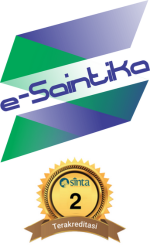Implementation of Molecular Visualization Program for Chemistry Learning
Abstract
Keywords
Full Text:
PDFReferences
ACD/ChemSketch. Retrieved from https://www.acdlabs.com/resources/freeware/chemsketch/
Avogadro. (2016). Retrieved from https://avogadro.cc/
Barak M., & Hussein-Farraj, R. (2012). Integrating model-based learning and animations for enhancing students' understanding of proteins structure and function. Research in Science Education, 43(2), 619-636.
Bolte, C., Streller, S., & Hofstein, A. (2013). How to Motivate Students and Raise Their Interest in Chemistry Eduaction. In I. E. a. A. Hofstein (Ed.), Teaching Chemistry – A Studybook (pp. 67-95): Sense Publisher.
Chandrasegaran, A. L., Treagust D.F., & Mocerino, M. (2008). An evaluation of a teacher intervention to promote students’ ability to use multiple levels of representation when describing and explaining chemical reactions. Research in Science Education, 38(2), 237-248.
Dicksona, H., Thompsona, C., & O’Toole, P. (2017). Developing a Common Visual Literacy Amongst First Year Chemistry Students. International Journal of Innovation in Science and Mathematics Education, 25(1), 1-13.
Dori, Y. J., & Kaberman, Z. (2012). Assessing high school chemistry students' modeling sub-skills in a computerized molecular modeling learning environment. Instructional Science, 40, 69-91.
Ertl, P. (2010). Molecular structure input on the web. Journal of Cheminformatics, 2(1).
Fadillah, A., & Salirawati, D. (2018). Analysis of misconceptions of chemical bonding among tenth grade senior high school students using a two-tier test. 2021, 080002. doi:10.1063/1.5062821
Febliza, A., & Okatariani, O. (2020). The Development of Online Learning Media by Using Moodle for General Chemistry Subject. Journal of Educational Science and Technology (EST), 6(1), 40. doi:10.26858/est.v6i1.12339
Garcia-Ruiz, M. A., Santana, P. C., & Molina, M. (2014). Using Effective Stereoscopic Molecular Model Visualizations in Undergraduate Classrooms. International Journal for Cross-Disciplinary Subjects in Education (IJCDSE),, 5(1).
Gilbert, J. K. (2005). Visualization: A metacognitive skill in science and science education. Visualization in Science Education (Vol. 1). Netherlands: Springer
Hake, R. (1999). Analyzing Change/ Gain Score. Indiana: Indiana University.
Hariyono, E., Prahani, B. K., & Mardiyanti, M. (2020). Volcano Project Design: Innovation In Geoscience Learning. Prisma Sains : Jurnal Pengkajian Ilmu dan Pembelajaran Matematika dan IPA IKIP Mataram, 8(2), 139. doi:10.33394/j-ps.v8i2.3267
He, Y., Swenson, S., & Lents, N. (2012). Online Video Tutorials Increase Learning of Difficult Concepts in an Undergraduate Analytical Chemistry Course. Journal of Chemical Education, 89(9), 1128-1132. doi:10.1021/ed200685p
Laksono , E. W., Rohaeti, E., Suyanta, & Irwanto. (2017). INSTRUMEN PENILAIAN KEMAMPUAN BERPIKIR ANALITIS DAN KETERAMPILAN PROSES SAINS KIMIA. Jurnal Kependidikan, 1(1), 100-110.
Levy Nahum, T., Mamlok‐Naaman, R., Hofstein, A., & Taber, K. S. (2010). Teaching and learning the concept of chemical bonding. Studies in Science Education, 46(2), 179-207. doi:10.1080/03057267.2010.504548
Mahdum, M., Hadriana, H., & Safriyanti, M. (2019). Exploring Teacher Perceptions and Motivations to ICT Use in Learning Activities in Indonesia. Journal of Information Technology Education: Research, 18, 293-317. doi:10.28945/4366
Mataka, L. M., & Kowalske, M. G. (2015). The influence of PBL on students' self-efficacy beliefs in chemistry. Chemistry Education Research and Practice, 16(4), 929-938. doi:10.1039/c5rp00099h
Morsch, L. A., & Lewis, M. (2015). Engaging Organic Chemistry Students Using ChemDraw for iPad. Journal of Chemical Education, 92(8), 1402-1405. doi:10.1021/acs.jchemed.5b00054
Pérez, J. R. B., Pérez, M. E. B., Calatayud, M. L., García-Lopera, R., Montesinos, J. V. S., & Gil, E. T. (2017). Student's Misconceptions on Chemical Bonding: A Comparative Study between High School and First Year University Students. Asian Journal of Education and e-Learning, 5(1), 1-16.
Rayan, B., & Rayan, A. (2017). Avogadro Program for Chemistry Education: To What Extent can Molecular Visualization and Three-dimensional Simulations Enhance Meaningful Chemistry Learning? World Journal of Chemical Education, 5(4), 136-141. doi:10.12691/wjce-5-4-4
Roche Allred, Z. D., Tai, H., Bretz, S. L., & Page, R. C. (2017). Using PyMOL to Explore the Effects of pH on Noncovalent Interactions between Immunoglobulin G and Protein A: A Guided-Inquiry Biochemistry Activity. Biochem Mol Biol Educ, 45(6), 528-536. doi:10.1002/bmb.21066
Seery, M. K. (2013). Harnessing Technology in Chemistry Education. New Directions, 9(1), 77-86. doi:10.11120/ndir.2013.00002
Seery, M. K., & McDonnell, C. (2013). The application of technology to enhance chemistry education. Chem. Educ. Res. Pract., 14(3), 227-228. doi:10.1039/c3rp90006a
Şen, Ş., & Temel, S. (2016). An Analysis of Prospective Chemistry Teachers’ Attitudes towards Information and Communication Technologies, and of Their Confidence in Technological and Pedagogical Content Knowledge. Participatory Educational Research, spi16(2), 1-10. doi:10.17275/per.16.spi.2.1
Sugiyono. (2012). Metode Penelitian Kuantitatif Kualitatif dan R&D. Bandung: Alfabeta.
Wood, R. (2019). Students’ Motivation to Engage with Science Learning Activities through the Lens of Self-Determination Theory: Results from a Single-Case School-Based Study. EURASIA Journal of Mathematics, Science and Technology Education, 15(7). doi:10.29333/ejmste/106110
Worlitz, J., Stabler, A., Peplowsky, S., & Woll, R. (2016). Video Tutorials: An Appropriate Way of Teaching QM Tools Applied with Software. Quality Innovation Prosperity, 20(2), 169. doi:10.12776/qip.v20i2.754
DOI: https://doi.org/10.33394/j-ps.v9i1.3941
Refbacks
- There are currently no refbacks.
Copyright (c) 2021 Risnita Vicky Listyarini

This work is licensed under a Creative Commons Attribution 4.0 International License.

J-PS (Prisma Sains: Jurnal Pengkajian Ilmu dan Pembelajaran Matematika dan IPA IKIP Mataram) p-ISSN (print) 2338-4530, e-ISSN (online) 2540-7899 is licensed under a Creative Commons Attribution 4.0 International License.








 https://orcid.org/0000-0003-4395-5221
https://orcid.org/0000-0003-4395-5221